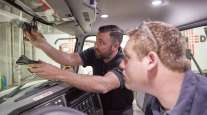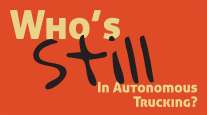iTECH: Generating Returns From Tech Spending
By Bruce Lilly, Contributing Writer
This story appears in the December 2014/January 2015 issue of iTECH, published in the Dec. 15 print edition of Transport Topics. Click here to subscribe today.
Carriers feel constant pressure to keep up with the latest technology, but choosing when and how to invest precious capital is not easy. There’s no simple tried-and-true formula for calculating the return on investment. One size doesn’t fit all in this industry.
First, recognize that all of the costs and benefits may not be obvious or easily measured. “There are hidden costs and hidden benefits,” said Vikas Jain, who currently is chief operating officer of Zonar Systems, in Seattle, but was senior manager of product marketing at Omnitracs, in San Diego, at the time of this interview. “It goes both ways. The costs that are most obvious to include when calculating ROI are the purchase costs and monthly subscription costs. Those are fairly standard and most explicit.”
Less obvious costs include the loss of productivity while scaling the learning curve that comes with new technology. “What people often don’t factor in are things like training or any kind of disruption that might occur as the organization deploys a new solution and moves from old processes to new processes,” Jain said. “The transition period may tax the organization in a variety of ways.”
RELATED: Careful Review of Results Vital for Technology ROI
Likewise, some of the paybacks are hard to measure. If a new technology allows you to avoid service failures or retain more drivers, that’s highly valuable. However, assigning a dollar figure to those gains must be done tentatively.
“Most technologies have side effects and side benefits that are material, but they may not be something that can be measured clearly when trying to calculate the ROI,” Jain said. Applications such as in-cab communications, navigation and electronic logs are examples, he said.
RELATED: Scale Technology to Meet Business Demands
“All of these applications give you an ROI purely from the cost savings in your operations, but one of the soft benefits is driver satisfaction,” he said. “In an industry in which growth is limited by the number of drivers that can be hired, being able to attract and retain drivers is clearly vital. That’s a soft, yet significant, benefit that technology would bring to the table.”
Another consideration on the cost side of the equation is maintenance and repair. “We’ve discovered that a lot of software systems have moderate maintenance and repair costs that are not usually considered in the ROI equation,” said Dan Murray, vice president of research at American Transportation Research Institute.
“For example, if an onboard safety system uses sensors that are on the outside of the truck, everything from hitting a pothole to a rock can essentially require that a new sensor be installed. You have the cost of the new sensor, you have to take the truck back to the shop and your technician must be trained and certified to install it.”
Failing to assess the total cost of ownership isn’t unusual, according to Deryk Powell, president and COO of Velociti Inc., a transportation-industry technology consultant based in Riverside, Missouri. “Understanding the total cost of ownership is a huge driver,” Powell said.
“Some people have a good handle on this, but others don’t. We see a lot of situations where fleets haven’t properly analyzed what it’s going to take to support and maintain a particular product. This means that they find the ROI that they expected to get is a very different number than the return they are actually getting.”
Another perspective to keep in mind when debating whether to acquire some new technology is the cost of not having it. “What will it cost if you don’t make this investment in technology?” asked Monica Truelsch, director of marketing at TMW, in Cleveland.
“What are you risking? If you don’t make this investment, but all of your competitors do, how does that make you look? How does that prepare you to survive in a tough marketplace? Opportunity costs are not always part of ROI calculations, but they should be, because they are important business drivers.”
In terms of benefits that may be hard to calculate, one example is the ability of technology to make people more productive. “Technology is a force multiplier,” Truelsch said. “That means that it empowers the same number of people to do so much more than they could before. This is part of evaluating comparative investments in technology. Where are you going to get the greatest force-multiplying effect from that investment?”
Another example is the challenge of providing more value to customers. “The decision to invest in technology is more than just the numbers that define ROI,” said transportation consultant Timothy Almack, a partner at Katz, Sapper & Miller, in Indianapolis. “We are seeing more and more carriers seeking to do more than just be a trucking company. They are branching out into warehousing, managing inventory and fulfillment, handling light assembly and packaging, and other services in an effort to get closer to their customers.”
According to Almack, trucking companies are experiencing increasing pressure to invest in technology so that they can provide services their customers desire. “EDI is a perfect example,” he said. “Carriers have to invest in technology to stay current. A lot of it is driven by the customer and the customer’s needs. As a trucking company executive, you need to ask what you need to do in terms of investing in technology to become more valuable to your customers.”
Technology can help trucking companies establish a unique profile. “Making the right choices about technology can be a significant differentiator in the market,” Jain said. “The kind of technology you choose to purchase and deploy can make you that much more effective or efficient, and you can use that attribute as a meaningful competitive advantage.”
When looking at some of the harder ROI numbers that come into play, such as fuel costs, one essential strategy for calculating the benefits from deploying a new technology is to establish a baseline of current performance. “When we’re working with a customer, we suggest that we start by putting the technology on a certain number of vehicles without changing anything operationally,” said Chris Oliver, chief marketing officer for Seattle-based Zonar Systems. “So you just capture the data from the way you have been operating, and this establishes your current levels as a baseline.”
Oliver used idle time as an example. “If you track 10 vehicles, you might learn that the average idle time per vehicle per day is 45 minutes,” he said. “Now you have a way to measure idle time. You’ve established a baseline against which you can measure your improvements. You can look at reports that show how things change over time.”
In other cases, there is no simple way to measure the return that comes from specific technologies. Jain pointed out that fleets commonly use multiple types of technology simultaneously to attack the same issue.
“Say that mpg has improved by 5%,” he said. “Maybe you did five things last month that could impact your mpg.
What role did each of those things play in your improvement? Most fleets have only the aggregate measurements. Technology companies need to look at this problem and develop more precision in terms of measuring their specific contributions. This is very important in our industry.”




